7 days in Kyoto: Our complete Kyoto itinerary
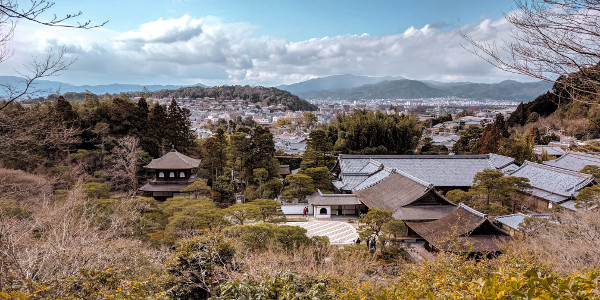
Kyoto is the former capital of Japan and is home to 1600 Buddhist temples and 400 Shinto shrines. With so many shrines and temples, there is lots to see and visit in Kyoto. We stayed in Kyoto for 7 days and visited a few of the shrines and temples, but we also walked around the traditional neighborhood Gion and visited the Arashiyama Bamboo Forest. Of course, one week isn’t nearly enough to see everything Kyoto has to offer. Read on to find out what we did in our complete 7-day Kyoto itinerary.
Day one
To-ji
The first temple we visited was To-ji. To-ji means East Temple and there used to be a West Temple as well (Sai-ji) but it was burnt down in 1233 and never rebuilt. To-ji was built in 796 and was one of the three temples that were allowed in Kyoto at that time. It’s the only temple remaining from the three, which makes it the oldest temple in Kyoto. The five-story pagoda is the tallest wooden tower in Japan. For the Pokémon fans among us: To-ji is likely one of the real-life temples on which the Bell Tower in Ecruteak City (Johto) is based (where you caught Ho-Oh in Gold/Silver!).
Prices
General admission: JPY 800
Opening hours
Daily: 8:30-16:30/17:30 (winter/summer)
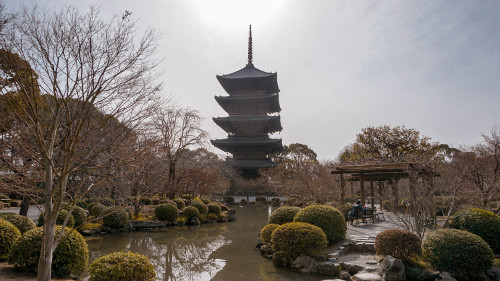
Kyoto Station
We spent a few hours exploring the building of Kyoto Station. There’s a huge mall in the station but also two viewing platforms. There’s a nice view over the Kyoto Tower from one of the platforms including some colorful art structures.
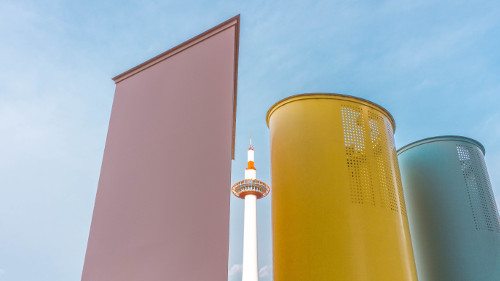
Kyoto Tower
The Kyoto Tower is located opposite of Kyoto Station. The tower is not that tall at 131 meters, but it’s the tallest structure in Kyoto. We didn’t go up to the observation deck of the tower, so we unfortunately can’t tell you what the view is like.
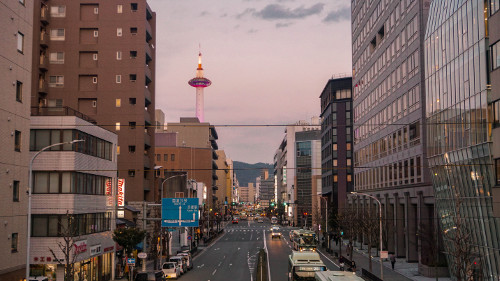
Day two
Arashiyama Bamboo Forest
One of the things Mika really wanted to see on our Kyoto trip was the Arashiyama Bamboo Forest. The tall bamboo is very impressive. We don’t know exactly why, but we expected the path through the forest to be way longer than it actually was. As the path through the forest is not that long, you should go as early as possible if you want to have the place to yourself. We got there around 9:00 and around 10:00 the place was totally packed. Getting a photo with nobody else in frame after 10:00 was impossible. We went there mid-winter and it was freezing and snowing that morning, so when the weather is better it might even be more crowded at an earlier time.
There’s no admission fee and it’s open 24/7.
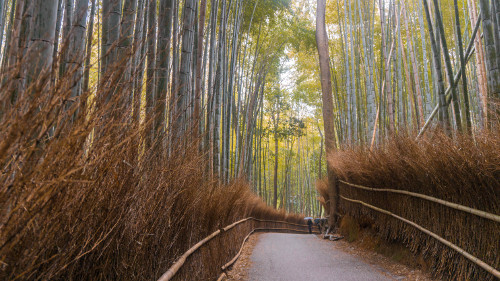
Gion
After warming-up, we wandered the streets of Gion in the afternoon. Gion is a district of Kyoto full of traditional houses, shrines and temples. You will see many people dressed up in Kimono here. The Gion district feels very ‘Japan-ish’ and it’s absolutely worth a visit.
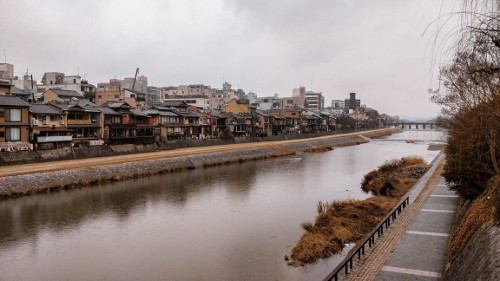
Hokanji
Hokanji is a temple in the Gion district. We didn’t visit the temple grounds but we wanted a typical Kyoto photo of a street with traditional Japanese houses and the Hokanji pagoda in the background. You will probably stumble upon the temple when you’re wandering around the streets of Gion.
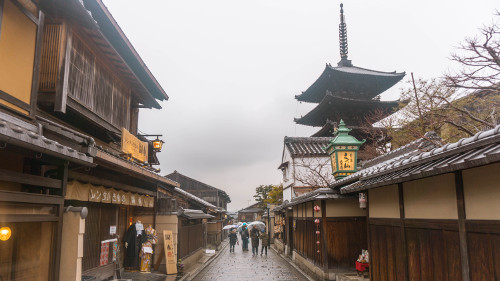
Day three
Fushimi Inari Taisha
Another sight Mika was dying to visit was Fushimi Inari Taisha. The shrine is located at the base of the mountain and the 4-kilometer trail to the top of the mountain is lined with thousands of torii. The first part of the mountain trail is very crowded. The longer you walk, the less crowded it gets. You will reach a view point first, which is not yet the top of the mountain. There are a few cafés over there and benches to take a rest. If you continue from there to the top of the mountain, you will only see a handful of people. It does take some time to get up the mountain though, especially when you take lots of photos like us.
There’s no admission fee (in general, the shrines in Kyoto are free to enter and to enter the temples you need to pay an admission fee) and it’s open 24/7.
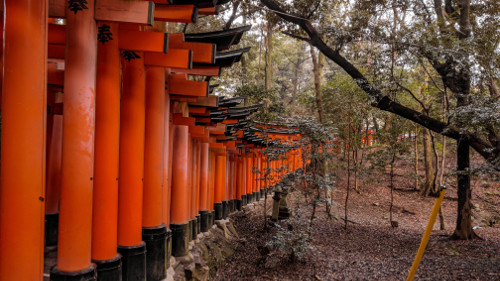
Kiyomizu-dera
Kiyomizu-dera is a temple located at the foot of a mountain in the Gion district. It’s one of the most popular temples and therefore the whole area is usually very crowded. It’s a very nice walk from the main shopping street (Shijo Dori) to the temple through the streets of Gion. The street leading to the temple is a tourist paradise filled with souvenir and soft serve ice cream shops. The grounds of Kiyomizu-dera are huge. The main hall is located partly on a lower part of the mountain and partly on pillars and it’s said to offer amazing views over the city. You need to pay an admission fee to enter the main hall, which we didn’t do. Large parts of the temple grounds are freely accessible.
Prices
Regular admission: JPY 300
Opening hours
Daily: 6:00-18:00/18:30
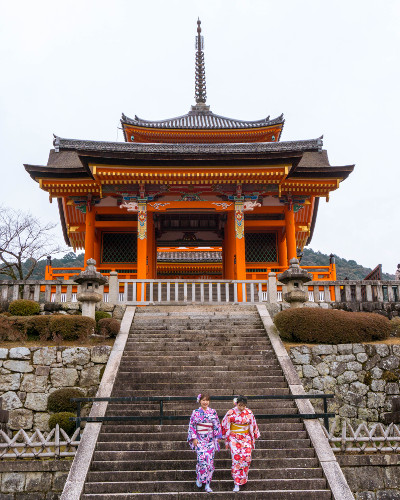
Pokémon Center
The Pokémon Center in Kyoto is located on the fifth floor in a large mall. It’s a bit hard to find, but if you go to the fifth floor of the Takashiyama Kyoto Store, you will find it eventually. As we had to go home after Kyoto for a week, we decided to buy ourselves some souvenirs!

Our shopping basket filled with Pokémon goods - we bought it all!
Day four
Ginkaku-ji
The meaning of Ginkaku-ji is Temple of the Silver Pavilion as it was initially planned to cover the exterior in silver foil. Ginkaku-ji is seen as the counter part of Kinkaku-ji: a temple which is covered in gold (see below). The temple is surrounded by a beautiful Japanese garden. The temple grounds are not that big and there’s a one-way path through the garden which you have to follow which ends in a souvenir shop. For the Pokémon fans among us: Ginkaku-ji is probably also one of the real-life temples on which the Bell Tower in Ecruteak City (Johto) is based.
Prices
Regular admission: JPY 500
Opening hours
Daily: 8:30-17.00 (summer) and 9:00-16:30 (winter)
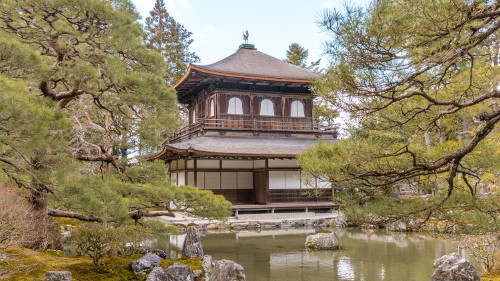
Mt. Daimonji-yama hike
Next to the Ginkaku-ji temple is the start of the Mt. Daimonji-yama hiking trail. The hike is a 1.5 km round-trip and is not hard, although it can be a bit steep and slippery sometimes. The view over the city is amazing! On clear days you can even see Osaka. The hike is popular with locals and you’ll probably be greeted a few times along the trail.
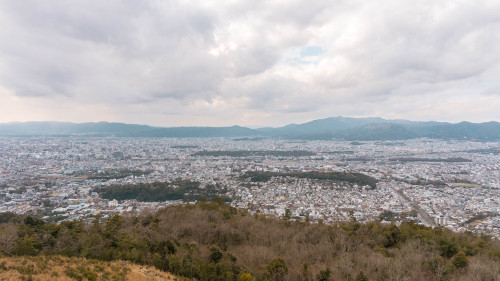
Philosopher’s Walk
The Philosopher’s Walk starts (or ends) near Ginkaku-ji. It’s a pedestrian path along a canal and is aligned with cherry blossom trees. The path is especially beautiful during cherry blossom season. During winter the branches are completely empty and the walk is not that special actually. Any other season would be better to visit the walk, because when the cherry blossoms are blooming, the path is absolutely stunning.

Okazaki Shrine
The Okazaki Shrine is a shrine where the rabbit is worshipped. The grounds of the shrine aren’t that big, but the shrine is beautiful. You can buy small rabbit figurines and place them in the temple. There are not as many rabbit figurines as there are cat figurines in Gotokuji in Tokyo, but it’s still pretty cool. It’s a nice place to visit when you are around and not only want to visit the well-known temples and shrines.
There’s no admission fee.
Opening hours
Daily: 9:00-17:00
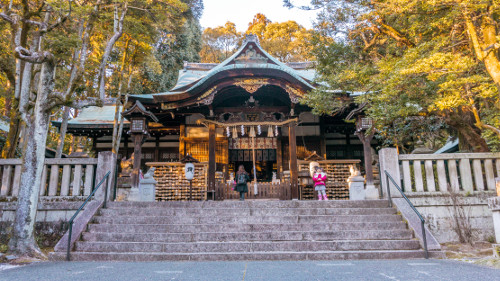
Day five
Kinkaku-ji
Kinkaku-ji is one of the most well-known and popular temples in Kyoto and is therefore always crowded. Kinkaku-ji literally means Temple of the Golden Pavilion as the temple is fully covered in gold. The temple was burnt down in 1950 and rebuilt in 1955. Just like its counterpart Ginkaku-ji (see above), Kinkaku-ji is surrounded by a beautiful Japanese garden. This beautiful temple is absolutely worth a visit!
Prices
General admission: JPY 400
Opening hours
Daily: 9:00-17:00
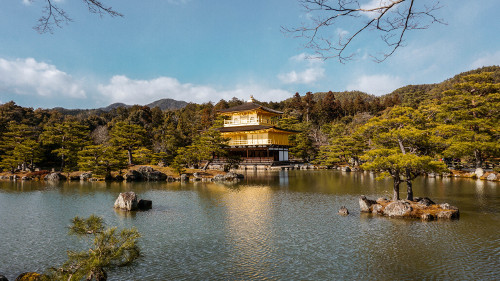
Day six
Yasaka Shrine
Yasaka Shrine is located at the end of the main shopping street Shijo-Dori and is a very popular shrine. The grounds of the shrine are pretty big and the buildings on it are definitely worth visiting. You will probably walk by this place anyway!
There’s no admission fee and it’s open 24/7.
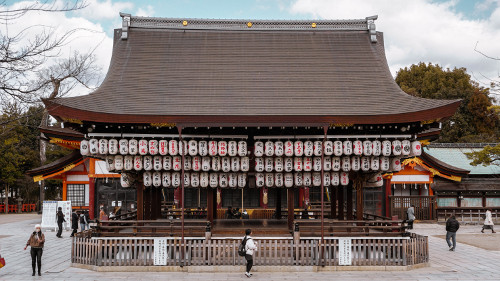
Railway Museum
On our last day we decided to visit the Railway Museum. The Museum is huge and filled with all kinds of Japanese trains. You can even look inside some of the trains and pretend to be the driver! It was lots of fun to see all these trains and it’s the perfect activity if you’re visiting Kyoto with little kids (which we weren’t). And if you’re a train enthusiast, it’s cool to see all the Japanese-made trains such as the first bullet train, the 0 Series Shinkansen.
Prices
JPY 1200 (adult)
JPY 1000 (university students – old university cards of foreign universities work, don’t ask why we know this)
Check this website for current ticket prices.
Opening hours
Daily: 10:00-17:30 (closed on Wednesdays)
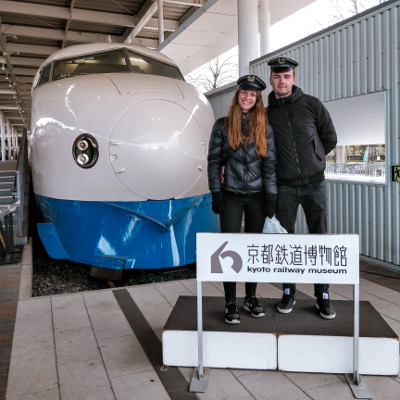
Getting around Kyoto
Getting around in Kyoto by public transport is pretty easy. There often is a train station nearby all the well-known tourist attractions. Depending on where you’re staying or coming from you might need to switch lines or ways of transport. Just as in Tokyo, there are different railway operators, but there are not as many different operators as in Tokyo so the struggle in Kyoto is way less. We didn’t take the bus in Kyoto, but we heard it’s pretty convenient.
Japan Rail Pass
We traveled from Tokyo to Kyoto by the world-famous high-speed train Shinkansen (also known as bullet train). The ride was very convenient and so fast. The distance between Tokyo and Kyoto is around 450km and the Shinkansen ride takes only two hours, which is absolutely incredible! When you’re visiting Japan it’s absolutely a must to take the Shinkansen. If you’re visiting multiple destinations in Japan, the Japan Rail Pass might be a great choice for you. The JR Pass offers unlimited rides on JR trains (including the Shinkansen) for one, two or three weeks at a very affordable price. Check out this website for current prices and to book your JR Pass.
Have you been to Kyoto? Let us know in the comments below!
Be sure to check out more of our visual experiences on Instagram!
More Japan
7 days in Tokyo: Our complete Tokyo itinerary
Snowboarding in Japan: Our experiences of ski resort Ishiuchi Maruyama

